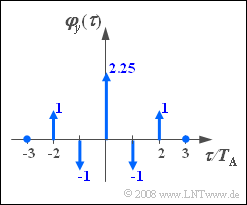Exercise 5.6: Filter Dimensioning
A discrete-time random variable $\left\langle \hspace{0.05cm}{y_\nu } \hspace{0.05cm}\right\rangle$ with the outlined ACF is to be generated using a digital filter.
Let the discrete-time Gaussian input values $x_\nu$ be characterized in each case by
- the mean value $m_x = 0$,
- the dispersion $\sigma_x = 1$.
Notes:
- The exercise belongs to the chapter Creation of Predefined ACF Properties.
- Autokorrelationsfunktion Auto-Correlation Function.
- Let all ACF values $\varphi_y(k \cdot T_{\rm A})$ with index $|k| \gt 2$ be zero.
Questions
Solution
- A recursive filter would always cause an infinitely extended impulse response $h(t)$ and thus also an infinitely extended ACF.
- Therefore, a non-recursive filter structure must be chosen here. The specified ACF requires the order $M= 2$.
- Since the input values are Gaussian distributed and mean-free, this also applies to the output values.
- When filtering stochastic signals, the following always applies: "Gauss remains Gauss and non-Gauss never becomes (exactly) Gauss".
(2) The system of equations is:
- $$k = 2\text{:}\quad a_0 \cdot a_2 = 1.$$
- $$k = 1\text{:}\quad a_0 \cdot a_1 + a_1 \cdot a_2 = - 1\quad \Rightarrow \quad \sqrt {u \cdot w} = - 1\quad \Rightarrow \quad u \cdot w = 1.$$
- $$k = 0\text{:}\quad a_0 ^2 + a_1 ^2 + a_2 ^2 = 2.25\quad \;\;\, \Rightarrow \quad u + w = 2.25 + 2a_0 \cdot a_2 = 4.25.$$
The system of equations with respect to $u$ and $w$ has two solutions:
- $u = 4, \ w = 0.25$: Because of the condition $a_2 = 1/a_0$ (see first equation), $a_0$ and $a_2$ have the same sign.
- Moreover, at least one of the two coefficients is greater than/equal to $1$.
- Thus the condition $a_0+a_2= \sqrt{w} = 0.5$ cannot be fulfilled.
- Therefore, the correct solution is $\underline{u = 0.25}, \ \underline{w = 4}$.
(3) The result of (2) means that $a_1 = \pm \sqrt{0.25} = \pm 0.5$.
- The positive value leads to the system of equations
$$(1) \hspace{0.5cm}0.5 \cdot \left( {a_0 + a_2 } \right) = - 1\quad \Rightarrow \quad a_0 + a_2 = - 2,$$ $$(2) \hspace{0.5cm}a_0 \cdot a_2 = 1.$$
- From this follows $a_0=a_2=-1$. With $a_1= 0.5$, the final result is:
- $$a_1/a_0 \hspace{0.15 cm}\underline{= -0.5}, \hspace{0.5 cm} a_2/a_0 \hspace{0.15 cm}\underline{= 1}.$$
- The solution $a_1= -0.5$ leads to $a_0=a_2=+1$ and thus to the same quotients.
(4) In general, this problem has $I = 4$ equivalent solutions $($mirroring/shifting as well as the multiplication by $-1$ in each case$)$.
- Since here the impulse response is symmetrical, there are however only $\underline{I = 2}$ different solutions:
- $$\text{Solution 1:} \ \ a_0 = +1,\quad a_1 = - 0.5,\quad a_2 = +1; $$
- $$\text{Solution 2:} \ \ a_0 = - 1,\quad a_1 = +0.5,\quad a_2 = - 1. $$
